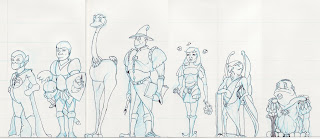In the summer of 2001, I was able to attend the School of Visual Arts on a scholarship. It payed for two courses. One was on Realistic Painting, the other on Character Development with Stanley Martucci. It was a fun time, going into the city, feeling the artistic vibe of the place, working for 4-5 hours, meeting great people and coming home late at night on the train.
We did 4 or 5 pieces as I recall, this one being all I have left from that time.
Upon my return to WCSU in the fall of that year, I focused on finishing designs. Up to this point I had just been working on heads and bits and pieces, but really hadn't worked on tying it all together.
This was also when Abe introduced me to the concept of
"What's the Big Idea?".
Essentially what he meant is that at the end of all your work, what direction will you go in? Will you take someone else's idea and develop it further? Or will you create your own project, with no boundary's or limitations?
I was just starting to get interested in animation, so I proceeded to take a dragon's head from my sketchbook and draw a animators concept sheet in three views.
This character known as
Soot, became the basis for an elderly dragon that no longer had the ability to breathe fire. The idea was to show a character that had grown well beyond the years of usefulness. Perhaps even lament on those years or be sorrowful for past wrongs.
The drawings line up Ok, but I've never tried to model this toon and it was the first time I had drawn wings.
In my final days at college, we had a Senior Portfolio show. One of the things I spoke to Abe about was not putting in any student work, only original pieces meant for the show.
And here's where I step on my soapbox again.
Student work does not belong in a portfolio.
Before you start yelling at me for such an insensitive comment, hear me out.
One day, you wake up and decide, "I want to be an artist."
That's great, but you'll have to learn all the rules of art and you'll have to practice....a lot. You'll be given assignments in school with deadlines...
simulating, but not substituting, what you might encounter out in the real world.
So you have a 16 week class, you will work on 15-30 pieces for that class and at the end, remark how improved your work is after a short amount of time. Your grade will reflect "
A" level work, your friends, teacher's and parent's, will tell you how great you are...
But it is still 'student' work....which can always be improved.
As far as the sheer number of pieces, imagine this idea by Malcolm Gladwell who theroized that it
takes 10,000 hours to master a skill.
So you have 5 (5hrs total) art classes a week (very difficult actually) for four semesters (over two years) and you have spent a combined maximum effort of 1600 hours in an art class environment. We know however that you are not making art during that entire time. There are lectures, individual meetings, critiques and general chatting with fellow students.
In short you'll have a way's to go before being able to Master the medium. And that's of course if you generally stick to only a few methods, instead of skipping around..trying different approaches.
Does that mean you won't be able to get paid work when you graduate? Nope.
You should have the necessary skills to get an art job done at this point, but in going back to the beginning of this discussion....a portfolio should show the maturity and work of what you have learned through original ideas and pieces.
And when I say original ideas...I mean the influence of your surroundings being used to create a response in the form of Art.
These pieces were original or responses...
This was an illustration using a Todd McFarland Spawn toy. It was a motorcycle, but I didn't like the wheels, so I illustrated it as a jet bike. I can't claim the original idea, but the drawing is original, because I 'observed' it and 'drew what I saw'. It therefore becomes a basis for skill level and not much more.
In this piece, I wanted to see how I was doing in improvement. The original b&W sketch was done while in the Navy, during the 80's. My method back then was largely 'trial and error'. Essentially I would draw/erase/and redraw until I was happy with the result. \
Later we will talk about how this method is replaced by multiple lines.
The blueline work is where I am revisiting an old piece, with my new found knowledge in art creating, using everything from control of the medium to advanced figure drawing to presentation.
And finally, detail and color. This one done in color pencil. I researched sundials for a composition involving the birth of dragons. Though the final piece was never finished (you'll have a lot of those), the intricacies and reference used on this one, still shows confidence and a solid understanding of light, warms and cools.
Revisiting successful old pieces, will give you greater clarity and direction on future work. You may even redo a piece or use it for reference on some future work.
Try not to hold on to every scrap of paper though, it's also a lesson to be able to 'let go' of that which no longer satisfies the creative soul.
Chris



















































